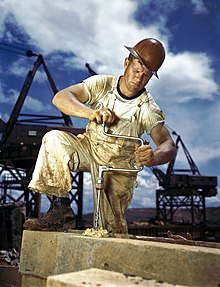From Wikipedia, the free encyclopedia
This article is about bib-and-brace overalls, also called "dungarees". For coveralls (boilersuits), see Boilersuit.
For other uses, see Overall (disambiguation) and dungaree.
"Shortall" redirects here. For the name, see Shortall (name).

A construction worker wearing overalls
Overalls, also called bib-and-brace overalls or dungarees, are a type of garment usually used as protective clothing when working. The garments are commonly referred to as a "pair of overalls" by analogy with "pair of trousers".[1]
Overalls were originally made of denim, but they can also be made of corduroy or chino cloth. Overalls were invented in the 1890s by Levi Strauss and Jacob W. Davis at Levi Strauss & Co., but they went through an evolution to reach their modern form.[2] Initially only used for protective clothing in work settings, they have become a garment of high fashion as "potential cult items".[3]
Beginnings
The exact beginnings of the wearing of overalls are unclear, but they are mentioned in literature as early as 1776 as protective working garments commonly worn by slaves.[4]
The first evidence of overalls being mass-produced are those made by Levi Strauss and Jacob Davis in the 1890s. The first "jeans" they invented were actually overalls ("waist overalls" or "waist-high overalls"), consisting of suspenders attached to denim pants with buttons but with no top part with a bib.[2] From the beginning, denim overalls were popular workers' garments due to their durability. In fact, Levi, Strauss & Co.'s slogan in the 1880s-1890s was "Never Rip, Never Tear".[5]
In 1911, Harry David Lee made the first bib overalls, made of pants with pockets with a bib and straps over the shoulders.[2]
In 1927, Lee's developed a "hookless fastener" and created "buttonless" overalls. Zippers replaced buttons.[2] Soon after, suspender buttons were traded in for belt loops to attach over-the-shoulder straps.[2]
The Overalls Movement of 1920[edit]
In 1920, groups of "Overalls Clubs" formed around the United States. They took overalls as their symbol to protest the rising cost of clothing, and profiteering in the garment industry.[6]
The Great Depression[edit]
In the 1930s, the poorest segments of the American population wore overalls: farmers, miners, loggers, and railroad workers.[7] They were most commonly worn by men and boys in the Southern and Midwestern United States. They can be seen in many of Walker Evans's photographs.[5]
Modern history[edit]
Bib overalls (in different colors and textiles) have become popular garments among American youth, from the 1960s onward.

Diesel Black Gold Fall/Winter 2010 Collection
In the 21st century, overalls have evolved into high-fashion garments. Designers such as Stella McCartney feature them in ready-to-wear collections for men, women, and children. Stella McCartney's children's overalls sell for as much as $138.[8] Nordstrom sells overalls for as much as $1,080.[9]


No comments:
Post a Comment